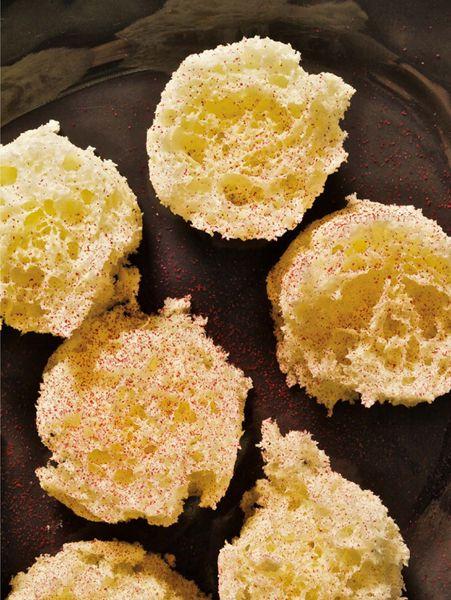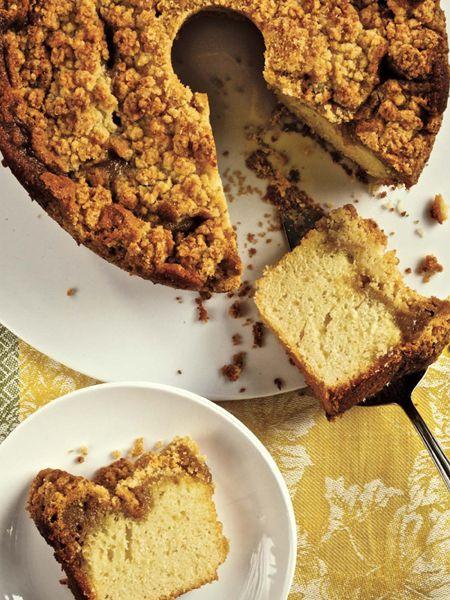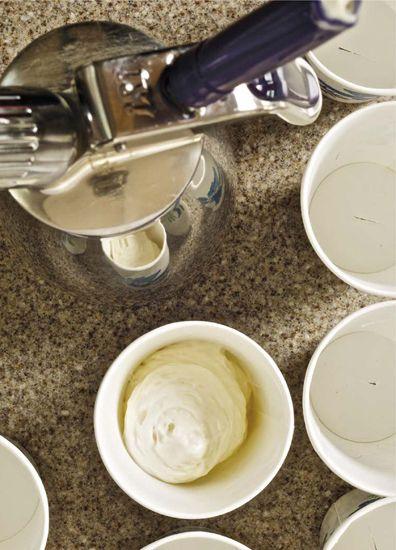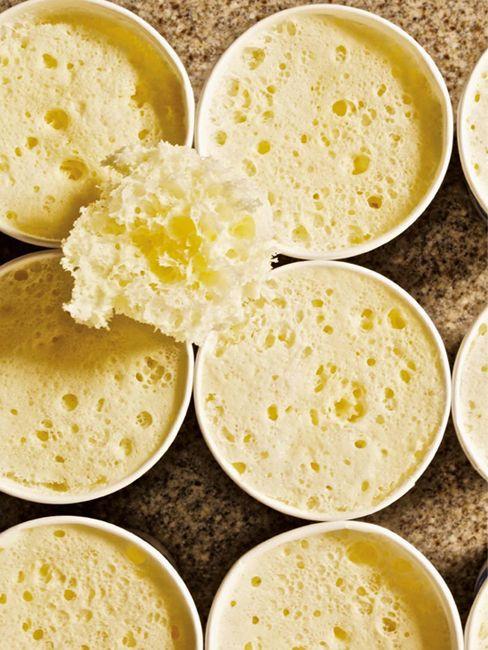Maximum Flavor: Recipes That Will Change the Way You Cook (4 page)
Read Maximum Flavor: Recipes That Will Change the Way You Cook Online
Authors: Aki Kamozawa,H. Alexander Talbot
Tags: #Cooking, #Reference, #Courses & Dishes, #General, #Methods

Distilled white vinegar
8 large cold
eggs
2 tablespoons 28 grams
olive oil
1 bunch
scallions,
green parts only, thinly sliced
Fine sea salt
and
freshly ground black pepper
MAKE THE SAUSAGE:
The day before serving, in a medium bowl, toss together the shrimp, wine, parsley, lemon zest, fennel seeds, onion powder, garlic powder, and pepper flakes. Grind in a meat grinder through the ¼-inch (6 mm) die. Alternatively, you can pulse the mixture in a food processor until minced. Gently mix the ground shrimp to make sure it is evenly combined and then put it in a large zip-top bag. Refrigerate for at least 4 hours and up to 12 hours.
MAKE THE GRITS:
Put 2 inches (5 cm) of water in the bottom of a pressure cooker and set a small rack in the bottom. Put the grits, water, skim milk, buttermilk, hot sauce, and salt in a bowl that will easily fit inside the cooker and stir to combine. Set the bowl on the rack and cook at high pressure for 10 minutes. Let the pressure dissipate naturally.
POACH THE EGGS:
Meanwhile, set a large pot of water with a generous splash of white vinegar over high heat. Once the water has come to a rolling boil, crack the eggs into a small bowl. Stir the water with a slotted spoon as you slide the eggs from the bowl into the water one by one. Turn the heat down to medium as the eggs slowly begin to coagulate in the pot. Do not let the water rise above a simmer. Cook until the whites are set and the yolks are still soft, 3 to 4 minutes, and then use a slotted spoon to transfer the eggs to a plate lined with a clean kitchen towel. Pat them dry with the edge of the towel or with a clean paper towel.
Set a large skillet over medium heat. Add the olive oil and, once it begins to shimmer, add the shrimp sausage. Cook the sausage slowly, turning and folding the mixture so that chunks of various sizes form, until lightly browned, 5 to 8 minutes. Remove the pan from the heat. Sprinkle with the scallions and stir gently to blend.
Open the pressure cooker—the grits may look separated and curdled, but just stir them with a silicone spatula and they will smooth out and become creamy. Spoon the grits into each of 8 bowls. Spoon the shrimp sausage over the grits and top with a poached egg. Season the egg with salt and pepper and serve immediately.
UNDER PRESSURE
It’s no secret that we love the pressure cooker. It’s probably the most efficient cooking tool available. We prefer the electric cooker because it is quieter, has its own timer, and is easier to clean, but whichever one you choose—electric or stovetop—you’ll be happy to have it in your kitchen. The days of exploding pressure cookers are long gone, as modern versions have several built-in safety measures to keep you safe in your kitchen, so there’s no reason why you shouldn’t get one of these amazing pieces of equipment.
Here’s a brief primer for those who don’t know how a pressure cooker works. As liquid boils inside it, steam is created. The steam builds up inside the chamber and exerts a uniform pressure on the ingredients inside. This pressure causes the temperature of the steam to increase. The increase in temperature is directly proportional to the amount of pressure, which is why most cookers have two settings, high and low pressure. Food cooks more quickly at high pressure. It’s worth noting that when using a pressure cooker, cooking times start once the cooker has reached full pressure, not from the time you turn on the heat. Additionally, unless you release the pressure manually, there is a cooling-down period as the pressure slowly dissipates inside the machine.
The pressure cooker creates a very moist environment inside the chamber, making it a great alternative for braises. Moist heat is wonderful for breaking down connective tissue and extracting gelatin. Starches and legumes also do very well in the pressure cooker, cooking much more quickly and uniformly than they do on top of the stove. We do a 5-minute low-pressure cook in plain water with kombu to take the place of presoaking, and then we pressure-cook our beans in seasoned liquid for anywhere from 10 to 45 minutes, depending on the size of the bean and the preparation. Cooking beans in a traditional fashion would take more than a day, so pressure-cooking greatly speeds up the process.
Coarse grits and hearty grains also cook in a fraction of the time in a pressure cooker versus regular cooking, and with no danger of scorching or boiling over. A 6-quart pressure cooker is the perfect size for small batches of stock made from the bones of last night’s dinner, or a batch of soup or chili for a last-minute dinner. The steam penetrates the food and the aromatics are contained in the chamber, creating a more flavorful end product. What’s not to love about that?

STRAWBERRY POWDER—DUSTED “DANISHES”
MICROWAVE CHEESE “DANISH”
THOUGH OFTEN MALIGNED, THE MICROWAVE IS A GREAT PIECE
of equipment that most of us have in our kitchens. Microwaves work by emitting radio waves that enter the food and interact with water, fats, and sugars, causing them to vibrate and creating heat in the food. Thicker, denser foods cook more unevenly because it’s harder for the microwaves to penetrate their interiors. Microwaves still cook more evenly than conventional ovens because the heat can be generated throughout the food instead of having to work its way from the outside in. We aerate the batter for these “Danishes” using an iSi whipped cream dispenser, and the batter expands easily in the microwave, creating a spongelike appearance and incredibly light texture while still retaining the creamy cheese flavor of an actual Danish. We like to pair them with fresh berries because the contrast of their sweet tart flavor and firmer texture helps bring out the ethereal qualities of these wonderful little cakes.
MAKES ABOUT 12 CAKES
9 tablespoons plus 1 teaspoon 150 grams
whole milk
5 tablespoons plus 2 teaspoons 24 grams
egg white powder
7 ounces 200 grams
cream cheese
¼ cup 75 grams
Lyle’s Golden Syrup
1 tablespoon plus 2 teaspoons 25 grams
all-purpose flour
¼ teaspoon 1.5 grams
fine sea salt
¼ cup 10 grams finely ground
freeze-dried strawberries,
for dusting the cakes (optional)
Put the milk in a blender and turn it on low speed. Sprinkle in the egg white powder and increase the speed to medium. Puree the mixture for 15 seconds. Turn off the blender and add the cream cheese, syrup, flour, and salt. Turn the speed to high and puree until smooth, at least 30 seconds.
Pour the batter into the 1-liter canister of an iSi whipped cream dispenser and put the lid on. Charge with one N
2
O charger and then shake to distribute the gas and allow it to be absorbed into the batter. Repeat with a second charger. The batter should feel and sound fluid in the canister. Take twelve 8-ounce (240 ml) paper cups and use the tip of a paring knife to make a slit in the bottom of each cup and 3 slits around the sides to let steam vent as the danishes cook. The batter will be thick enough to not leak through. Dispense the batter into the paper cups, filling each halfway. Working with one at a time, microwave on high for 30 seconds. Immediately remove the cup from the microwave and invert it (with the cake still in it) and set it on a plate or tray to keep the cakes from falling as they cool.
Once all the cakes are cooked, refrigerate the cups (still inverted) for at least 1 hour, until they are fully chilled and set. Use a paring knife to loosen the edges of each cold “Danish” from its cup and shake it free. Use a small fine-mesh sieve to dust the cakes with freeze-dried strawberry powder, if desired, and serve immediately.
USING AN ISI WHIPPED CREAM DISPENSER TO FILL PAPER CUPS WITH BATTER
JUST-BAKED MICROWAVE CHEESE “DANISH”

SOURDOUGH COFFEE CAKE
INSPIRED BY THE GREAT ST. LOUIS GOOEY BUTTER CAKE, THIS
recipe has a gooey layer to go underneath the streusel on an otherwise classic coffee cake. The flavor of the sourdough gives a wonderful tanginess that balances the sugar.
If you want to change things up, you could add up to a cup of chopped fruit between the gooey and streusel layers or add up to a teaspoon of your favorite sweet spices like cinnamon, ginger, nutmeg, or clove to the batter in the initial beating stage. Whole grain devotees may want to substitute up to 1 cup of whole-grain flour for the all-purpose—or you could go whole hog and use 100 percent white whole wheat flour (just remember to increase the baking powder by ½ teaspoon/3 grams if you go that route). Another variation we love is to substitute ½ cup (43 grams) cocoa powder (we like King Arthur Double-Dutch Dark) for flour to make a chocolate sourdough cake—and/or you can add 1 cup (170 grams) chocolate chips or 1 cup (150 grams) roasted nuts to the finished batter before you pour it into the cake pan. We love how versatile this recipe is!
One note: Remember to make the streusel topping before the gooey topping and cake batter because they all get layered together before the cake goes into the oven.
MAKES ONE 9-INCH / 23 CM TUBE CAKE
GOOEY TOPPING
8 tablespoons 113 grams
unsalted butter,
at room temperature
¼ cup packed 50 grams
dark brown sugar
1 cup 200 grams
granulated sugar
¼ teaspoon 1.5 grams
fine sea salt
1 large
egg yolk,
at room temperature
3 tablespoons 56.25 grams
Lyle’s Golden Syrup
2 tablespoons 28 grams
water
½ teaspoon 2 grams
vanilla extract
1 cup 150 grams
all-purpose flour


